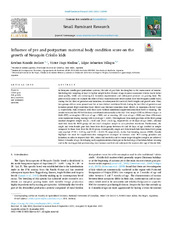- RDI Principal
- →
- Facultad de Ciencias Agrarias
- →
- Artículos
- →
- Ver ítem
JavaScript is disabled for your browser. Some features of this site may not work without it.
Mostrar el registro sencillo del ítem
| dc.creator | Jockers, Esteban Ricardo | |
| dc.creator | Medina, Víctor Hugo | |
| dc.creator | Villagra, Edgar Sebastian | |
| dc.date | 2021 | |
| dc.date.accessioned | 2022-08-02T16:28:53Z | |
| dc.date.available | 2022-08-02T16:28:53Z | |
| dc.identifier.uri | http://rdi.uncoma.edu.ar/handle/uncomaid/16810 | |
| dc.description.abstract | In Neuqu ́en Criollo goat production systems, the sale of goat kids for slaughter is the main source of income. Marketing kids weighing at least 14 kg live weight before 90 days of age improves economic returns due to better meat quality, while also reducing doe lactation requirements and subsequent pressure on grazing land. The present study aimed to evaluate the effect of body condition score (BCS) in does from the Neuqu ́en Criollo breed during the last third of gestation and lactation, on subsequent kid survival, birth weight and growth rate. Thus, two groups of does were penned and fed at two distinct nutritional levels during the last third of gestation and lactation period: High Condition Score (BCS3) and Medium Condition Score (BCS2), to maintain a BCS of 3 and 2, respectively. Kids remained with their dams without nutritional supplementation from birth to weaning. The results indicated that BCS of the dam contributed substantially in the kids’ live weight (LW) in different stages: at birth (BW), at slaughter (50 days of age = 50D) and at weaning, (90 days of age = 90D) and these differences were maintained during rearing (220 days of age = 220D). The single and twin male goat kids of the BCS3 group reached slaughter weight (15.16 ± 0.08 and 14.15 ± 0.51 kg, respectively) at 50 days of age (50D), whereas male kids from the BCS2 group did not reach slaughter weight in an equivalent timeframe. Furthermore, the single and twin female goat kids born from BCS3 group between 50 and 90 days of age doubled in weight compared to those born from the BCS2 group. Consequently, single and twin female kids born from BCS3 group only reached 17.52 ± 0.12 kg and 15.52 ± 0.43 L W, respectively, in the first breeding season (220D). Results highlight the need for supplementation management strategies to increase does’ BCS during gestation and lactation; in order to improve kids’ BW, reduce kid mortality and to ensure target slaughter weights are achieved before 2 months of age. Developing early supplementation strategies in the last stage of lactation before weaning and in the rearing period post-weaning may increase survival and anticipate the reproductive age of female kids | es_ES |
| dc.format | application/pdf | es_ES |
| dc.language | eng | es_ES |
| dc.publisher | Elsevier | es_ES |
| dc.rights | Atribución-NoComercial-CompartirIgual 2.5 Argentina | es_ES |
| dc.rights.uri | https://creativecommons.org/licenses/by-nc-sa/2.5/ar/ | es_ES |
| dc.subject | Criollo goat | es_ES |
| dc.subject | Kids growth | es_ES |
| dc.subject | Body condition | es_ES |
| dc.subject | Late pregnancy | es_ES |
| dc.subject | Lactation | es_ES |
| dc.subject.other | Ciencias Agrarias y Forestales | es_ES |
| dc.title | Influence of pre and postpartum maternal body condition score on the growth of Neuquén Criollo kids. | es_ES |
| dc.type | Articulo | es |
| dc.type | article | eu |
| dc.type | acceptedVersion | eu |
| dc.description.fil | Fil: Jockers, Esteban. Facultad de Ciencias Agrarias, Universidad Nacional del Comahue; Argentina. | es_ES |
| dc.description.fil | Fil: Medina, Víctor. Facultad de Ciencias Agrarias. Universidad Nacional del Comahue; Argentina. | es_ES |
| dc.description.fil | Fil: Villagra, Edgar Sebastian. Universidad Nacional de Río Negro; Argentina. | es_ES |
| dc.description.fil | Fil: Villagra, Edgar Sebastian. Instituto de Investigaciones Forestales y Agropecuarias de Bariloche; Argentina. | es_ES |
| dc.cole | Artículos | es_ES |



